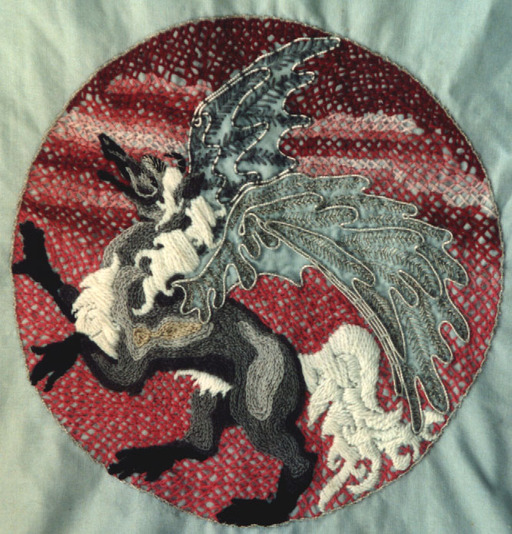Though I never officially joined the SCA , I attended a number of events in the mid 80s, and needed something to wear. The closest friend I had in the organization admired my embroidery skills (as no-one else has before or since, except perhaps my brother John) and reawakened my flagging interest. So I made a design the fantasy animal I had created in college when unicorns got just too cute and popular for words, substituting for my typical satin stitch chain stitch for much of the animal's body, couching and a sort of feather stitch for its wings, and coarser (#5 perle) threads for the mane and tail. I seem to recall the project taking about 20 hours to do, which isn't bad for something this large; and I was pleased enough with results, especially when larded up with lots of jewelry, never to get around to finishing anything more elaborate.
Since both the tunic and rejiquar are grey I embroidered the background as well, choosing cross stitch (partially in ombre floss for additional interest), again to cover a large area rapidly. Cross stitch has always struck me as among the least imaginative approaches to embroidery–even in canvas work the stitcher can employ a variety of size and shaped stitches, whereas cross, though the substrate allows for unlimited freedom, constricts the options to 3 variations of one stitch, a flat, nearly textureless surface, and often, insipid, pastel designs to boot. It should be obvious that I favor freestyle embroidery; by varying the size and shape of the crosses I was able to avoid the regimented look, which would have looked silly with so organic (and organically worked) a subject.
My goal was to create something attractive and quick, that I wouldn't feel badly about throwing in the washing machine. (I washed all my embroidered clothes regularly, and was somewhat astonished to discover that typically the clothes wore out before the needlework.) Along the way I discovered that texture–in the form of the more open stitches and various floss thicknesses–could more than make up for the loss of richness implied by satin stitch. Very little about this piece is period, however: my contemporary sensibilities were already in conflict with the authenticity that is, after all, the SCA's raison d'etre.

Six-strand (25) and No. 5 perle cotton DMC embroidery flosses, including ombres; metallic (mylar covered?) silver cord, possibly stretchy, DMC 3 ply metallic silver; legs done in ultra-shiny Deutsch thread, “marlitt”. Collection of the Artist.
Originally created: Sun Aug 30 10:49:38 EDT 1998
Unless otherwise noted, text, image and objects depicted therein copyright 1996--present sylvus tarn.
Sylvus Tarn